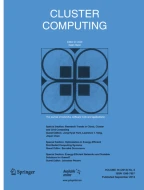Abstract
According to many published literature, parallel computing is regarded as an efficient solution in digital terrain analysis (DTA) of geographic information system. The stable and credible services play an irreplaceable role in the high performance computing, especially when an error occurs in large-scale science computing. In this paper, a new approach for the parallel DTA considering the performance of fault-tolerance was proposed: fast parallel re-computation (FPR). FPR owns a fast self-recovery ability based on redundancy mechanisms compared to other fault-tolerant methods. Once some errors in application layers are detected, the data block having computation errors is further partitioned into several sub-blocks, which are re-computed by the surviving processes concurrently to improve the efficiency of failure recovery. The overlapping strategy of error detection and re-computation is presented through decomposing the data block into several logic sub-blocks. As a result, when an error of a logical sub-block of the data block is detected by a comparing thread the re-computing process immediately starts to correct the error. This strategy reduces the time of re-computation and error detection by overlapping them comparing the traditional re-computation method. The experiments show that the proposed FPR method can achieve better performance efficiency with fewer overhead.
Similar content being viewed by others
References
Song, X., Tang, G., Li, F., et al.: Extraction of loess shoulder-line based on the parallel GVF snake model in the Loess hilly area of China. J. Comput. Geosci. 52(1), 11–20 (2013)
Group, W., Lusk, E.: Fault tolerance in MPI programs. Spec. Issue J. High Perform. Comput. Appl. 18, 363–372 (2002)
Cauchi-Saunders, A., Lewis, I.: GPU enabled XDraw viewshed analysis. Int. J. Parallel Distrib. Comput. 84(7), 87–93 (2015)
Gomez, L., Maruyama, N., Cappello, F., Matsuoka, S.: Distributed diskless checkpoint for large scale systems. In: 10th IEEE/ACM International Conference on Cluster, Cloud and Grid Computing (CCGrid), Melbourne, Victoria, 17–20 May, pp. 63–72 (2010)
Li, Y., Lan, Z.: A fast restart mechanism for checkpoint recovery protocols in networked environments. In: IEEE International Conference on Dependable System and Networks, pp. 217–226 (2008)
Rao, S., Alvisi, L., Vin, H.: Egida: an extensible toolkit for low-overhead fault-tolerance. In: IEEE Fault-Tolerant Computing Symposium (FTCS-29), Madison, WI, June, pp. 48–55 (1999)
Patel, J., Fung, L.: Concurrent error detection in ALUs by re-computing with shifted operands. IEEE Trans. Comput. C.31(7), 589–595 (1982)
Mozaffari-Kerimani, M., Manoharan, N., Azarderakhsh, R.: Reliable radix-4 complex division for fault-sensitive applications. IEEE Trans. Comput. Aided Des. Integr. Circuits Syst. 34(4), 656–667 (2015)
Mozaffari-Kerimani, M., Manoharan, N., Azarderakhsh, R.: Efficient error detection architectures for CORDIC through recomputing with encoded operands. In: IEEE International Symposium on Circuits and Systems (ISCAS), pp. 2154–2157 (2016)
Yang, X., Du, Y., Wang, P., et al.: The fault tolerant parallel algorithm: the parallel re-computing based failure recovery. In: 16th International Conference on Parallel Architecture and Compilation Techniques (PACT), Brasov, Romania, 15–19 September, pp. 199–209 (2007)
Du, Y., Tang, Y., Xie, X.: A new parallel recomputing code design methodology for fast failure recovery. J. Comput. Electr. Eng. 39(4), 1095–1113 (2013)
Evans, J.: Fault Tolerance in Hadoop for Work Migration. Technical Report CSCI B534, November. Indiana University (2011)
Goiri, I., Julia, F., Guitart, J., Torres, J.: Checkpoint-based fault-tolerance infrastructure for virtualized service providers. In: IEEE/IFIP Network Operations and Management Symposium, April, pp. 455–462. IEEE, Osaka (2010)
Plank, J., Li, K., Puening, M.: Diskless check-pointing. IEEE Trans. Parallel Distrib. Syst. 9(10), 972–986 (1998)
Engelmann, C., Geist, A.: A diskless check-pointing algorithm for super-scale architectures applied to the fast Fourier transform. In: IEEE 1st International Workshop on Challenges of Large Applications in Distributed Environments (CLADE), Seattle, WA, 21 June, pp. 47–52 (2003)
Song, X., Dou, W., Tang, G., Yang, K., Qian, K.: A diskless check-pointing algorithm for cluster architectures applied to geospatial raster data processing. J. Algorithms Comput. Technol. 8(4), 369–387 (2014)
Bronevetsky, G., Marques, D., Pingali, K., Stodghill, P.: Automated application-level checkpoint of MPI program. In: ACM Symposium on Principles and Practice of Parallel Programming (PPoPP), San Diego, CA, 11–13 June, pp. 84–94 (2003)
Chen, Z., Dongarra, J.: Highly scalable self-healing algorithms for high performance scientific computing. IEEE Trans. Comput. 58(11), 1512–1524 (2009)
Dou, W., Miao, S.: Performance analysis for fast parallel recomputing algorithm under DTA. In: 14th International Symposium on Distributed Computing and Algorithms for Business, Engineering, and Sciences (DCABES), Guiyang, China, 18–24 August, pp. 46–49 (2015)
Miao, S., Dou, W., Li, Y.: An error-detecting approach for fault tolerance parallel recomputing with parallel digital terrain analysis. J. Algorithms Comput. Technol. 10(1), 52–61 (2016)
Miao, S., Dou, W., Li, Y.: Study on error-detecting approach for fault tolerance recomputing oriented parallel digital terrain analysis. In: Distributed Computing and Algorithms for Business, Engineering, and Sciences (DCABES), Xianning, Hubei, 29–30 November, pp. 148–151 (2014)
Miao, S., Dou, W., Li, Y.: Research on the fast parallel re-computing for parallel digital terrain analysis, In: Second International Conference on Geo-informatics in Resource Management and Sustainable Ecosystem (GRMSE), CCIS 482, pp. 244–251 (2014)
Acknowledgments
This work has been substantially supported by the National Natural Science Foundation of China (No. 41171298). We also thank the reviewers’ pertinent comments to provide a qualified paper for readers.
Author information
Authors and Affiliations
Corresponding author
Rights and permissions
About this article
Cite this article
Dou, W., Miao, S. A fast parallel re-computation with redundancy mechanism for parallel digital terrain analysis. Cluster Comput 19, 1769–1785 (2016). https://doi.org/10.1007/s10586-016-0644-z
Received:
Revised:
Accepted:
Published:
Issue Date:
DOI: https://doi.org/10.1007/s10586-016-0644-z
